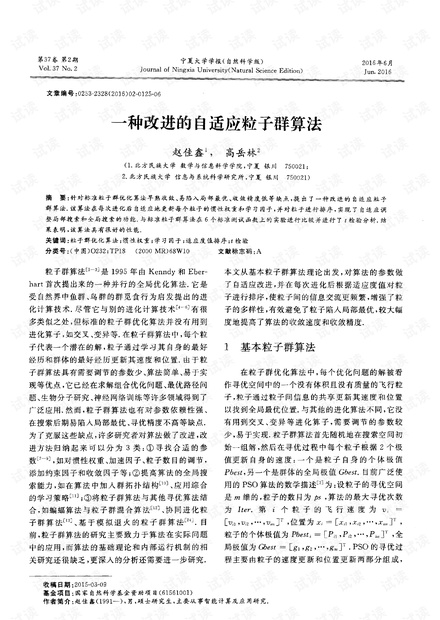"一种改进的自适应粒子群算法"
particle swarm optimization algorithm is a heuristic optimization algorithm based on swarm intelligence, which is inspired by the foraging behavior of bird flocks and fish schools. The algorithm is simple, easy to implement, and has fewer parameters to adjust. However, it also has some drawbacks, such as premature convergence, easy to fall into local optimum, and low convergence precision.
To overcome these shortcomings, many researchers have proposed improved algorithms, which can be divided into three categories: ① finding suitable parameters, such as adjusting inertia weight, acceleration factor, and population size; ② improving the algorithm's global search ability, such as introducing topological structure and hybrid learning strategies; ③ combining particle swarm optimization with other optimization algorithms, such as bat algorithm and simulated annealing.
This paper proposes an improved adaptive particle swarm optimization algorithm, which updates the inertia weight and learning factor of each particle adaptively, and sorts the particles according to their fitness values. This enables more frequent information exchange between particles, increases the diversity of particles, and effectively avoids falling into local optimum. The algorithm has better convergence speed and precision compared to the standard particle swarm optimization algorithm.
The algorithm is applied to six standard test functions, and the results show that the improved algorithm has better performance. The paper also analyzes the influence of parameters on the algorithm's performance and provides guidelines for parameter selection.
In summary, the improved adaptive particle swarm optimization algorithm has the advantages of simple implementation, fewer parameters to adjust, and good optimization performance. It has broad application prospects in solving complex optimization problems.
Knowledge points:
1. Particle swarm optimization algorithm: a heuristic optimization algorithm inspired by the foraging behavior of bird flocks and fish schools.
2. Drawbacks of particle swarm optimization algorithm: premature convergence, easy to fall into local optimum, and low convergence precision.
3. Improved adaptive particle swarm optimization algorithm: updates inertia weight and learning factor adaptively, and sorts particles according to their fitness values.
4. Advantages of improved adaptive particle swarm optimization algorithm: better convergence speed and precision, simple implementation, and fewer parameters to adjust.
5. Applications of particle swarm optimization algorithm: combination optimization problems, path optimization problems, biological molecular research, neural network training, and other fields.
Key terms:
* 粒子群优化算法 (particle swarm optimization algorithm)
* 惯性权重 (inertia weight)
* 学习因子 (learning factor)
* 适应度值 (fitness value)
* 排序 (sorting)
* 局部最优 (local optimum)
* 全局最优 (global optimum)
* 收敛速度 (convergence speed)
* 收敛精度 (convergence precision)



















